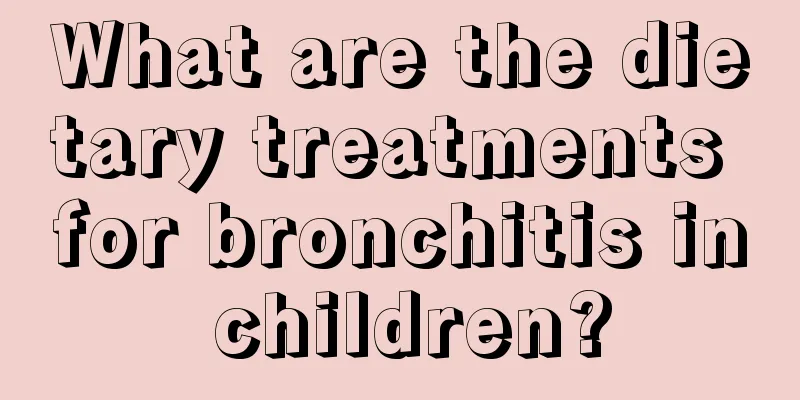What causes allergies in children? These reasons are the most common!

|
Allergies are very common. Young infants and children have weaker body resistance, so the probability of allergies is much higher than that of adults. As they age, allergies become less and less common. Different allergens can cause different allergic symptoms, and the severity of allergies also varies. Severe allergies may be life-threatening. So what are the causes of allergies in children? 1. Causes of skin allergies in children Pediatric skin allergy is an inflammatory skin disease characterized by redness, swelling, and itching. After the allergy occurs, the baby will scratch and cry repeatedly, and in severe cases it may cause loss of appetite, which in turn affects the mental state. 1. Genetic factors. A tendency to be prone to allergies can be inherited. If parents are allergic to pollen, pets or certain foods, their children have a 50% chance of developing allergies. If both parents have allergies, the child has a 75% chance of developing allergies, and the same is true for skin allergies. 2. Children’s skin is delicate. Skin allergies are more common in children than in adults. This is because babies' skin is more delicate than adults', so they are more susceptible to various conditions such as skin allergies and dry skin. 3. Allergy to toiletries. When a baby has skin allergies and develops a red, itchy rash, it may be easy to think that the skin allergies are caused by the toiletries the baby uses daily. In fact, skin allergies and rashes may be caused by a variety of reasons. Don’t simply think that you can just stop using or change skin care products and ignore the real "culprit" causing the baby’s skin allergies. 2. Symptoms of skin allergies in children Skin allergy symptoms usually appear in several forms. One is the perceived symptoms, such as itching and tightness; the other is the external symptoms, such as redness, desquamation, swelling, etc. Of course, the more serious situation is that both symptoms exist. Symptoms of skin allergies in children include general symptoms and behavioral changes, and often appear half an hour to several hours after children are exposed to allergens. 1. General symptoms include flushing of the cheeks, nose and earlobes, moist ear canals, earache, nasal congestion, sneezing, dark circles under the eyes, swollen and drooping eyelids, headaches, dry lips, dry skin or sweating, wrinkles at the corners of the eyes or palms, abdominal pain, diarrhea, bloating, constipation, eczema on the arms, legs or joints, recurrent infections, chronic cough, asthma, shallow and rapid or irregular breathing, pulse disorder, high blood pressure, tight joints, etc. 2. Behavioral changes Children of different age groups exhibit different behaviors. 0-1 year old infant group: continuous crying or screaming, unable to eat or needing to eat constantly, irritable or extremely lethargic, difficulty falling asleep or drowsiness, unwilling to be held, shaking head, etc. 1-3 years old children: have unexplained temper tantrums, are overly active, jump around, hit the bed, feel tired, curl up in dark corners such as under tables and chairs, under the bed or inside furniture, refuse to be touched, are unwilling to dress or undress, etc. Children aged 3-6 years: sudden changes in mood and behavior, hyperactivity, inability to sit quietly to eat, listen to stories or watch TV programs, irritability, fatigue, disobedience, depression, aggressive behavior, shaking legs, drowsiness or nightmares, inability to write or draw in a horizontal line, or the words become larger and curled upwards (excited type), or the words become smaller and curled downwards (depressed type), intermittent difficulty speaking, bedwetting after the age of 5, etc. 3. What to do if your child has skin allergies In the process of children's skin allergies, allergic mediators play a direct role. Allergens are a necessary condition for the occurrence of allergic symptoms, and the presence of a large number of free radicals is the root cause of children's skin allergies. Free radical oxidation destroys the cell membranes of mast cells and alkaliphils, causing them to be damaged and denatured, which reduces the body's immune capacity and creates conditions for the occurrence of abnormal immune reactions of antigens and antibodies, leading to cell rupture, the release of allergic mediators, and the occurrence of allergic symptoms. Most anti-allergic drugs work by competing with allergic mediators in the nasal mucosa, skin blood vessels, and bronchial smooth muscle cells, rendering them ineffective. Once the drug's effects wear off, allergies will recur. Moreover, many drugs can cause users to become drowsy. Although some aerosol-type hormone drugs take effect quickly, the symptoms and side effects are more severe when the disease relapses. The root cause of allergies is the patient's allergic constitution. To treat skin allergies, you must start by improving the allergic constitution. |
<<: What are some ways to promote children's brain development?
>>: What may cause urticaria in children?
Recommend
What to do if your child has separation anxiety
In today's society, more and more children ha...
Treatment of molluscum contagiosum in children
The treatment of molluscum contagiosum in childre...
The reason why the baby's tongue is yellow
It is particularly painful for an inexperienced m...
What to do if the boy's urethra is red and swollen
When taking care of a child, mothers need to be b...
What causes blisters on children?
Be especially careful when blisters appear on chi...
When is the oral stage for babies?
The development of the baby's oral stage begi...
What should I do if my baby has a runny nose and sweats? These methods are very useful
When a baby has a runny nose, it is likely a symp...
What medicine should children take for cough and white sputum
Many children have severe coughs, because their c...
What to do if your 3-year-old child has bad breath
Bad breath is more common in adults, but children...
What happens if a child has itchy red bumps on his body?
Many people often have itchy skin, especially som...
How to educate a willful baby?
In daily life, appropriate praise of children can...
What should I do if my child accidentally drinks liquor?
People drink many kinds of alcohol in their lives...
What should I do if my baby has severe prickly heat?
In hot and humid seasons, infants and young child...
What are the dangers of thrombocytosis in children?
When children are young, they always have some sy...
Children with diarrhea should be cautious when using 5 types of drugs
Diarrhea is prevalent in summer, especially among...









